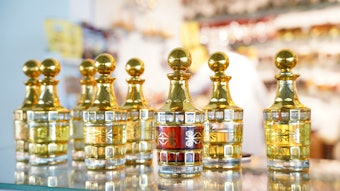
Is psychodermatology the new ayurvedic skin care? How do these concepts align with holistic beauty? These ideas and others – including connections with sensitive skin, photodamage protection and the future of holistic beauty – were explored with Shilpi Jain (SJ), a research and development scientist and founder of the prestige brand Skinveda. Following is an adapted transcript from the interview.
C&T: How does psychodermatology echo ancient ayurvedic beliefs?
SJ: Psychodermatology is an idea that just came into fruition in the mid-20th century, but it dates back to Hippocrates, who found that when we are fearful, our heart rate increases and this leads to sweating of the skin. The brain and central nervous system and the skin share the same ectoderm origin. So psychodermatology highlights the bridge between the brain and the skin. There are several skin diseases like psoriasis, eczema, rosacea, etc., that all relate to your emotional and mental well-being.
Ayurveda, on the other hand, is a 5,000-year-old medicine that has been practiced in India for the longest time. The whole premise behind ayurveda is the balance of the three vital energies (doshas). These are really based on your mind-body constitution and how it is affected by extrinsic and intrinsic stress factors. This is reflected in your skin – so it’s the manifestation of stress in your body’s largest organ.
So, I think ayurveda does echo into psychodermatology, where the latter would be considered more contemporary or modern. But ayurveda is more specific, specialized and personalized.
C&T: Do these concepts fit into holistic beauty? And does this shift into mind-body connections mean formulators need to understand psychology and biology on top of chemistry?
SJ: Yes, ayurveda would be considered holistic beauty because it looks at a 360-degree approach to your skin. It’s not one-size-fits-all. It’s looking at your diet, your lifestyle, the weather you live in, the way you behave toward any stressful situation – everything affects your skin. Ayurvedic solutions, of course, are concoctions of herbs – many of which are used as biomimetic compounds. We see them in today’s products that are more medicinal. Take salicylic acid, for example. You can find it naturally in some of these herbs. So ayurveda is geared toward holistic aspects and it’s integrative and preventative.
As a chemist, if you are formulating an ayurvedic product, you need to have knowledge of the skin but you also need to understand the doshas – the mind-body constitutions of a person. A quiz or questionnaire can help you really understand what a person needs to balance the doshas. You don’t really need to be a dermatologist but you do need to understand the physiology of the skin and the person’s behavior, e.g., mental patterns that are associated with their particular skin disease.
Also, you need to have knowledge of herbs because they can be very potent and powerful. You cannot just throw in turmeric and coconut or neem and assume that you’ve got an ayurvedic formulation. Every herb is very specific to treat certain diseases or skin issues.
C&T: How do psychodermatology and ayurveda relate to sensitive skin?
SJ: Psychodermatology connects the dots between understanding the skin and why it becomes sensitive. Skin sensitivity indicates the dermal-epidermal junction barrier has been compromised or damaged, and this can promote or exacerbate certain skin diseases.
Going back to psoriasis or eczema, these are conditions where there is increased skin sensitivity, which can cause you to become more reactive in given situations; upon contact with fragrance, for example. Sensitive skin elevates everything – every proponent of skin issues including dryness. So essentially, psychodermatology looks at aspects of skin sensitivity from an angle of what condition your skin is in and what has been compromised.
However, ayurveda is based on what your dosha balances are. I’ll give an example. The vata dosha is signified by wind and its imbalance means there is excessive dryness in skin. In this case, you can imagine someone who is always on the go and who is exposed to extremely harsh winter conditions. They will have very dry skin. To counteract this using ayurveda, you would administer something that is warming, giving the individual ingredients to help normalize the cold, dry skin conditions. This could include using oils and abhyanga (self-massage).
In the case of the pitta dosha, signified by fire, an imbalance can aggravate skin, leading to inflammation. These afflicted individuals are more prone to sunburn and should not be outside when the sun is at its brightest because UV radiation can increase this sensitivity.
So ayurveda looks at sensitivity in a very different – yet similar – way. It is focused on your doshas and where you are currently, in terms of your doshic imbalances. And there are very specific routines that can be advised to help mitigate skin sensitivity.
C&T: What is the third dosha type? And are there aspects of each or one type in particular that is more prone to sensitive skin?
SJ: All three can have sensitive skin. The third dosha is kapha, which is signified by earth. These people are more grounded but especially during rainy seasons – since doshas are very seasonally affected – kaphas’ skin sensitivity can be due to excessive cold or rain, and this can lead to congestion of the skin. This means the dilation of pores and flare ups.
If I were to look at all three doshas, I would say that pitta dosha seems to undergo the most sensitivity due to the weather and diet. These individuals are more prone to inflammation and skin sensitivity, and they tend to have the worst dermal-epidermal junction and compromised skin.
C&T: In terms of photodamage, are there any psychodermatology-inspired or ayurvedic approaches to help protect against or repair it?
SJ: I would say both psychodermatology and ayurvedic approaches are proponents of using a good sunscreen to protect against UV radiation and photodamage. Psychodermatology would look to certain ingredients such as actives to help block radiation; this could be a chemical or an organic sunscreen. It would also look at how products, ingredients or damage affects your overall skin. It would likely not be very personalized because it is just trying to provide a good sunscreen.
There is where consumers need to understand if they are sensitive to certain ingredients. They need to read the label and try to understand what works best for them. Some people, for example, cannot use organic sunscreens, they can only use inorganic sunscreens with zinc oxide or titanium dioxide.
Ayurveda, again, looks at photodamaged skin from the angle of your dosha (and if you’re a pitta dosha, why were you in the sun for such a long time!?). To address sun damage, ayurveda being a holistic medicine, it would of course look at natural ingredients and try to include certain things to help increase the sun protection factor.
For example, there are many oils in ayurveda that have an SPF of their own. By using them as delivery systems or carriers of inorganic pigments or organic pigments, you can create an ayurvedic sun care routine that is more holistic and natural – yet still very effective because they are still chemical compounds; but they are found naturally in given herbs.
Coconut is one such oil. I don’t know the exact SPF but it’s relatively high. Tulsi oil is another; it has ursolic acid in it and other photoactive compounds. In the Western world, argan oil also has an SPF. I know it’s not ayurvedic but I wanted to mention it. Jojoba and sunflower oils are additional examples.
C&T: What future directions do you see for holistic beauty?
SJ: I think holistic beauty is ever-evolving and there’s huge potential in the future to integrate modern technology from AI or smart skin care devices. Perhaps there is an app to determine what a person’s current imbalances or doshas are, or what their skin type is – something that integrates the ayurvedic proponent of imbalances and personalization to that level.
I also think inclusivity is gaining respect among consumers, so any skin care brand that is holistic would need to understand inclusivity in terms of gender type, race, ethnicity, skin color – everything. This means acknowledging diversity by creating products for all Fitzpatrick scales – more of a “biophilic” approach to beauty. Also, discovering, extracting and using the specific components in natural ingredients that are actually beneficial to your skin. These are all important aspects of holistic beauty taken to the next level.
Lastly, I think collaborating with mental health professionals could be a future direction if a skin care brand could find a fit where consumers can discuss their issues. There are so many mental health issues that have a direct effect on the skin. We know that. Scientifically, it’s been proven that there’s a major brain-skin-gut connection. So, if we could collaborate between mental health professionals, doctors and skin care brands, that would be huge.










